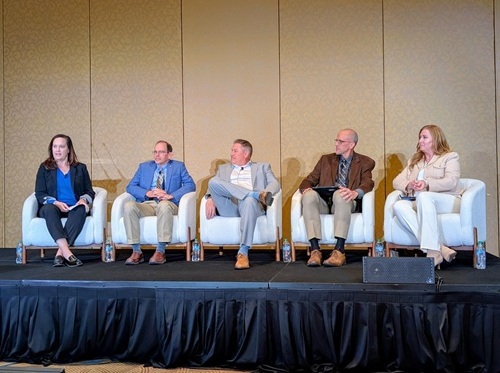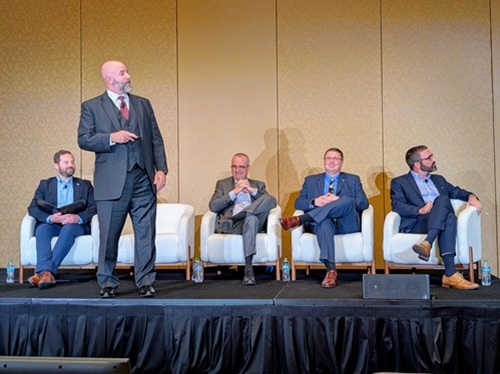A session at the Transportation Research Board’s 2024 Annual Meeting in Washington, D.C., delved into how various technologies, non-technology solutions, and policies to support them both are being deployed across the country in efforts aimed at beefing up protections for pedestrians and bicyclists – referred to as “vulnerable road users” or VRUs.
[Above photo by AASHTO]
Diane Gutierrez-Scaccetti – commissioner of the New Jersey Department of Transportation, chief of staff for Governor Phil Murphy (D), and outgoing chair of the TRB executive committee – noted during the session that her agency uses several different technologies to improve safety for both motorists and pedestrians alike.
“We are using a camera system to help manage [traffic] signal timing,” she explained. “The cameras identify pedestrians waiting to cross the intersection and eliminates the need for manual [crossing] signal activation. It’s about balancing traffic congestion and [vehicle] wait times with saving lives and reducing injuries.”
Gregory Slater, chief executive Tampa Hillsborough Expressway Authority and former secretary of the Maryland Department of Transportation, noted that his agency is testing out ways to build more connections between motorists and VRUs via technology to improve safety for both.
“We are using our system and downtown Tampa as a ‘test bed’ for connected technologies that provide two-way communication between motorists and bikes, scooters, and pedestrians,” he said. “As [vehicles] approach bicyclists or pedestrians, they communicate to both via audible warnings. It is also about using camera to detect them [VRUs] before you can see them; especially if the vehicle’s visibility blocked. But the piece we feel is really important is connectivity – that is the true equalizer, whether you use cellular or other communication technology. This will be the key to making intersections safer.”
Dr. Henry Liu, with the University of Michigan and director of its “Mcity” testing facility as well as the school’s Center for Connected and Automated Transportation, echoed Slater’s view on the role technology can play to improve safety for VRUs.
“Sensor data allows VRUs and V2X [connected-to-everything] vehicles to share data,” he said. “Connectivity is so important to improving safety on our roadways, but so is the trust factor – if the vehicle does not trust the message coming from the infrastructure, that will be an issue. We need to ensure the trust in the messages.”
Paul Scullion, director of safety at the Alliance for Automotive Innovation, added that building as much redundancy as possible into these connected systems is critical as well.
“Vehicle manufacturers are looking for ways to work together and leverage technologies to reduce pedestrian injuries and fatalities,” he said. “We are also looking at ways to leverage vehicle connectivity and roadside infrastructure – that will help us shift our focus [as manufacturers] from crash worthiness to crash avoidance.”
That being said, Scullion emphasized that it takes time not only to widely deploy new technology throughout the motor vehicle population but understand its weak spots as well.
“It takes time for the vehicle population to turn over, for technological advances to become more widespread,” he noted. “We also have to understand limitations of technology as well and what affects it, such as communication band interference.”
Jessica Cicchino, vice president of research for the Insurance Institute of Highway Safety, made similar points at the session.
“Connectivity will help where we see shortcomings for today’s vehicles,” she said. “For example, larger vehicles are over-involved in turning crashes [with VRUs] and we suspect that has to be related to visibility issues.”
Cicchino also noted that mapping out how technology “countermeasures” need to evolve over time is another key issue. “We want to make technology standard as soon as possible as widely as possible, so it gets pushed down to the used vehicle market more quickly,” she said “But technology implemented today does not solve problems instantly tomorrow. We also need to focus on the whole system and how each piece interacts in order to build in more redundancy. We also need to think about how technology might need to change as the problems systems address potentially change over time.”
However, Gutierrez-Scaccetti stressed during the session that technology is only a tool and “not the only answer” for improving protections for VRUs.
“There are many practical things we can do that are not expensive to improve pedestrian safety,” she noted. “We conduct a lot of outreach to children in elementary schools because I don’t want education to be determined not important – we need to teach children how to cross the street; looking both ways, crossing at the light. We are not doing this as frequently as we should.”
Gutierrez-Scaccetti said improving VRU safety means “encompassing everything from the simple to the technology-focused” to improve roadway safety. It’s also about working closely local communities about what works for their specific locales and what doesn’t.
“The key thing to remember is that we are going into people’s neighborhoods where we don’t live to solve roadway problems,” she pointed out. “This is why continual outreach and education is so important. We need to develop safety solutions that are acceptable to them – because they will be dealing with them on a day-in and day-out basis.”
 Nation
Nation
Building More Resilient Transportation Systems
November 21, 2025 Nation
Nation

